21 Mushrooms that Grow On Trees (with Pictures): Identification Guide
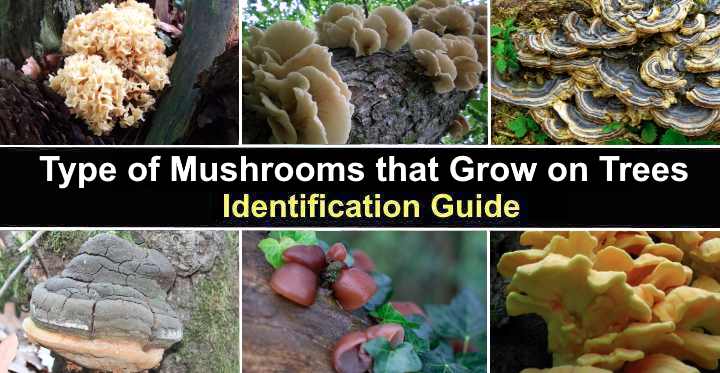
Mushrooms growing on trees are a common sight in backyards. The spongy orange or brown fruiting bodies appear fascinating as they grow like small shelves or brackets. While many tree mushrooms sprout on rotting wood, it’s not unusual to observe large fungal growth on living trees.
Various types of mushrooms can grow on trees. These include bracket fungi, which appear as shelf-like structures on tree bark; parasitic fungi, such as honey fungus, which harm living trees; saprophytic fungi that feed on decaying wood; and polypore fungi, recognized by pores beneath their caps.
This article examines the main types of mushrooms that grow on trees. You will also learn why mushrooms grow on trees and whether you should be concerned about tree fungi.
Please note that the purpose of this article is not to determine the edibility of tree mushroom species. Instead, its goal is to describe identifying features of tree mushrooms. Always consult a mushroom expert—a mycologist—before consuming any unfamiliar wild mushrooms. Remember, even mycologists may struggle to differentiate some poisonous mushrooms from edible ones.
Why Mushrooms Grow on Trees
Mushrooms growing on living trees can be a sign of rot, damage, or disease of the tree’s heartwood. Mushrooms are the fruiting bodies of mycelium—the network of fungal threads infecting the tree’s trunk. When conditions for fungal growth are optimal—high humidity, heat, and shade—mushrooms sprout from the mycelium.
Mushrooms growing on trees feed on the lignin and cellulose present inside the wood. Trees and their roots provide the carbohydrates and nutrients required for the fungi’s growth.
Do Mushrooms Growing on Trees Damage Trees?
Some types of fungal growth indicate the tree is suffering from internal damage. Enzymes from mushroom roots decompose the tree from the inside. Once the damage is significant, mushrooms sprout on the tree trunk’s exterior. Additionally, mushroom spores easily spread on the wind to other trees, infecting them and spreading fungal diseases.
Mushrooms growing at the base of backyard trees can also indicate damage. Tree fungi like honey mushrooms and cauliflower mushrooms attack the tree, impacting its health. These brownish-yellow or white mushrooms can cause early leaf drop and root decay. If left untreated, the tree roots will eventually die along with the infected tree.
However, not all mushrooms damage trees. Some types of tree mushrooms are saprophytes. This means they only feed on dead, decaying organic matter. Therefore, you may find mushrooms growing on fallen branches or dead tree trunks. These harmless mushrooms include shiitake, artist conk, and turkey tail.
Of course, mushrooms growing in your backyard are not always a problem. Lawn mushrooms are typically a sign of healthy soil because the mushroom’s mycelium helps decompose decaying organic matter. This process releases nutrients into the soil, which encourages a healthy ecosystem.
What Kind of Mushrooms Grow on Trees?
It’s important to identify the type of mushroom growing on trees. You should examine the fruiting body’s cap, type of underside (if it has gills or pores), and where it’s growing on the tree.
Here are common types of mushrooms that commonly grow on trees in yards:
Cap fungus: These mushrooms on trees have distinctive flat caps and tube-like stipes (stems). Common types of cap fungi on trees are oyster mushrooms, shiitake, and honey mushrooms.
Shelf fungus: Also known as bracket fungi or shelf mushrooms, these tree-dwelling fungi have flat, often circular, or shelf-like caps. These conspicuous growths attach firmly to tree trunks or branches. Types of shelf mushrooms growing on trees are chicken-of-the-woods, turkey tail, beefsteak fungus, and maitake mushrooms.
Jelly fungus: This type of tree-dwelling fungus is identified by its gelatinous, translucent appearance. These gelatinous fungi attach to tree branches or bark. They can resemble ears, brains, blobs, or wavy sheets. Types of jelly fungus growing on trees include witches butter, jelly ear, and wood ear.
Type of Mushrooms that Grow on Trees: Identification Guide
Let’s look in more detail at the identifying features of the most common mushrooms that grow on landscape trees.
Oyster Mushrooms (Pleurotus ostreatus)
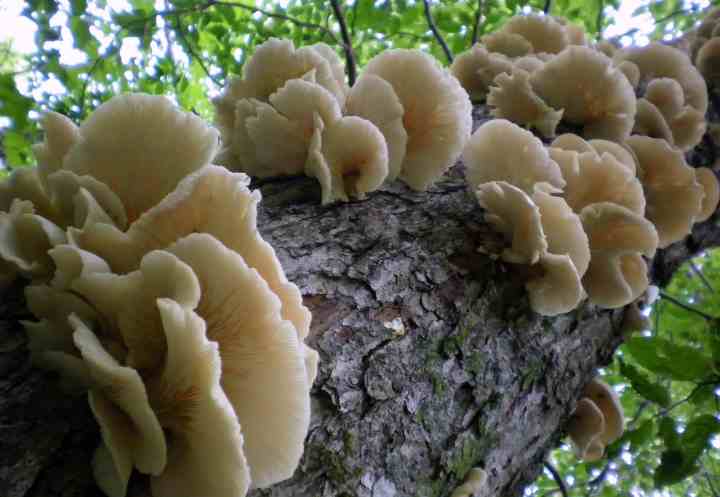
Oyster mushrooms are a popular type of white mushroom that grows in shelf-like clusters on trees. Also called tree mushrooms, the white-capped fungi are identified by their broad, fan-shaped cap and a short, off-center stem. Oyster mushroom caps can be white to grayish-brown with gills on the underside.
Oyster mushroom caps grow 1.18” to 6” (3 – 15 cm) and typically lack stems. The flesh of the edible white mushroom is white and doesn’t change color when cut. They typically grow on deciduous trees like oak and beech.
Phoenix Oyster (Pleurotus pulmonarius)
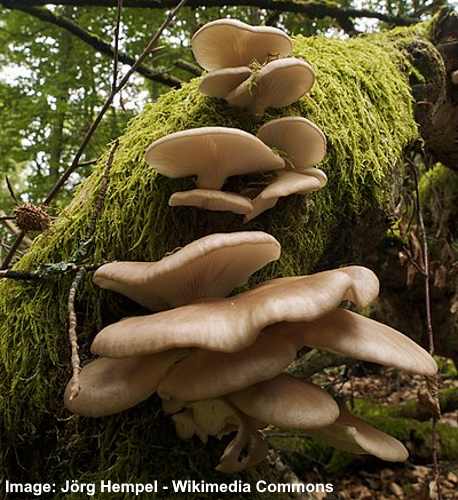
The Phoenix oyster is an edible mushroom commonly found growing on hardwood trees in backyards and woodlands. The cap is lung-shaped, white, or beige, with white gills running down the stems. Also called the lung mushroom or Italian oyster, the caps grow 1.18” to 4” (3 – 10 cm) across.
Phoenix mushrooms growing on living trees can damage them because they are saprobic fungi. These parasitic mushrooms attack susceptible trees and can affect the tree’s heartwood growth. However, it’s a useful edible mushroom growing on dead or decaying wood, as it helps organic matter decompose.
Lion’s Mane (Hericium erinaceus)
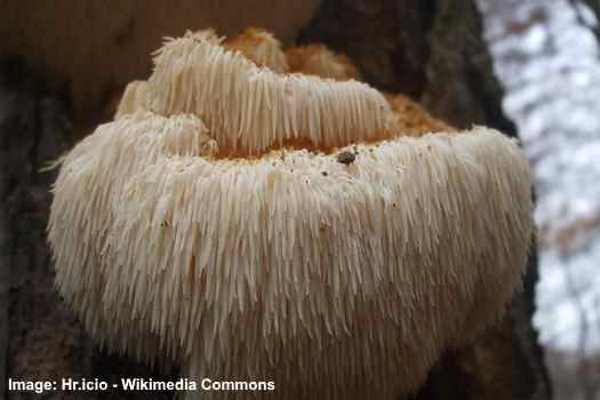
Lion’s mane is a unique and easily recognizable parasitic white mushroom that grows on the side of trees. The fruiting bodies of this unusual tree mushroom are bulbous tubercules growing 2” to 15.5” (5 – 40 cm) in diameter. They have dangling spore-producing spines 2” (5 cm) long.
Host trees for lion’s mane fungi are broadleaf trees. When growing on living trees, the fungus has saprophytic and parasitic qualities, which can damage tree health. It typically appears on oak trees in late summer and fall in temperate climates.
Also called the mountain-priest mushroom or bearded tooth mushroom, the striking clumping white mushroom is edible. However, it is important to be cautious and ensure proper identification, as there are some toxic lookalikes. Therefore, it’s recommended to consult a knowledgeable forager or mycologist before consuming wild mushrooms.
Hen of the Woods or Maitake Mushrooms (Grifola frondosa)
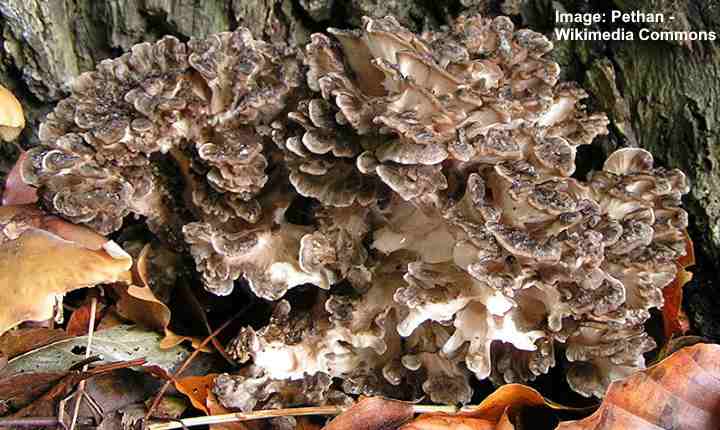
Hen-of-the-woods are soft-fleshed polypore mushrooms commonly found growing at the base of trees. Common on oak and maple trees, the large mushrooms are identified by their grayish-brown spoon-shaped caps with wavy margins. The clusters of mushrooms can grow up to 40” (100 cm) wide on dead wood and living oaks.
Hen-of-the-woods are parasitic mushrooms that can weaken healthy trees in your yard. The large fruiting bodies can weigh up to 50 pounds (22 kg). It’s an edible mushroom with a rich, earthy flavor to enhance the taste of soups, stir-fries, and other dishes. It also goes by the name “maitake mushroom.”
Chicken of the Woods (Laetiporus sulphureus)
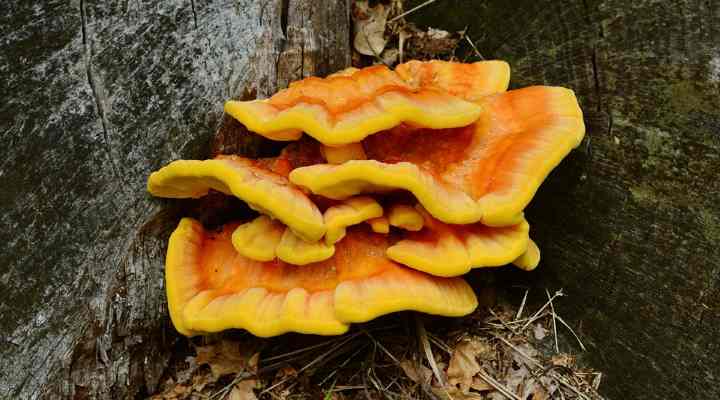
Chicken-of-the-woods is a type of orange or yellow mushroom commonly found on downed trees, decaying trees, and living trees. The edible, clumping mushroom has distinctive fan-shaped caps, creating a shelf-like structure 2” to 23.5” (5 – 60 cm) across. The caps are smooth and have a velvety texture. The undersides of the caps have small pores instead of gills.
This orange or yellow, edible, culinary mushroom is named chicken-of-the-woods because of its texture and chicken-like taste when cooked. The bright orange to yellow mushroom typically grows on hardwood trees and conifers. The mushroom can damage trees by causing brown rot in the wood.
Turkey Tail (Trametes versicolor)
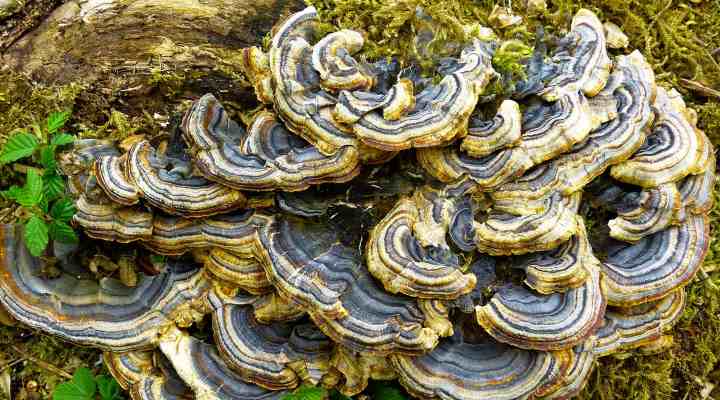
Turkey tail is a common tree mushroom identified by its fan-shaped appearance, resembling the tail feathers of a turkey. The distinctive mushroom has colored caps with white, cinnamon brown, gray and black markings, creating a shell-like appearance. The caps measure 0.79” to 3.14” (2 – 8 cm) across, and their undersides have pores instead of gills.
Turkey tail mushrooms grow on downed trees, tree stumps, and decaying logs. This grayish-brown or beige mushroom is inedible and mostly appears in late summer and the fall in woodlands in North America.
Beefsteak Polypore (Fistulina hepatica)
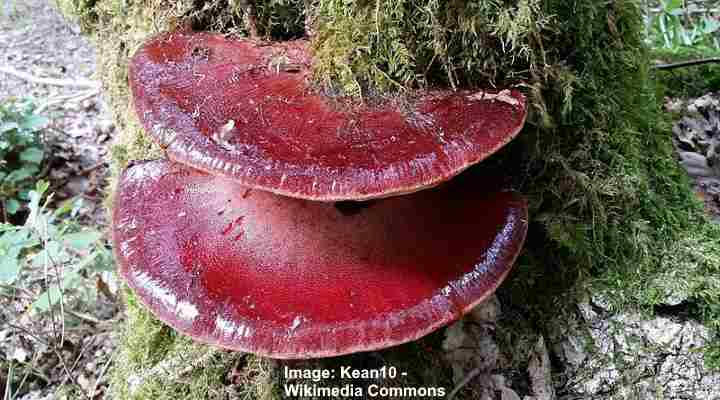
Also called the tongue mushroom, this striking red mushroom is commonly found growing on the side of oak trees. The mushroom’s identifying features are its red cap, sometimes with a lobed or wavy margin, pale pinkish porous underside, and white flesh. The fleshy parasitic mushroom grows near the base of trees.
Beefsteak or ox tongue mushrooms grow 2.75” to 7.87” (7 cm) wide and up to 2.4” (6 cm) thick. The cap’s surface is smooth, shiny, and sticky when young. These tree mushrooms have a parasitic relationship with the tree, causing the wood to decay. This mushroom is most commonly seen from late summer to fall.
Honey Mushroom (Armillaria mellea)
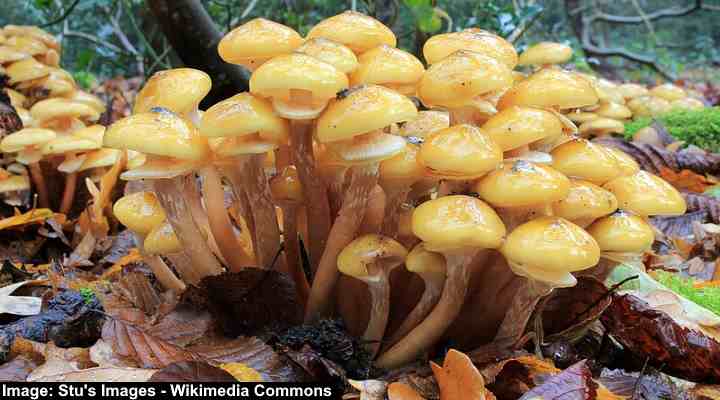
Honey mushrooms are a golden brown, edible fungus commonly found growing in clusters at tree bases. The small mushrooms are easy to identify by their long, slender stems, white gills, and caps that are convex when young and maturing to flat. The mushrooms grow 2.75” to 7.87” (7 – 20 cm) tall with caps up to 4.7” (12 cm) across.
Honey mushrooms are often found on various hardwood trees, such as oak, beech, maple, birch, and elm. While less common, honey mushrooms can also grow on coniferous trees like pine, spruce, and fir.
Honey mushrooms appear in the fall and have a sweet, honey-like aroma. The golden-orange mushrooms infest the roots of hardwood trees and cause root rot, which can result in reduced growth, branch dieback, and death.
Cauliflower Mushrooms (Sparassis crispa)
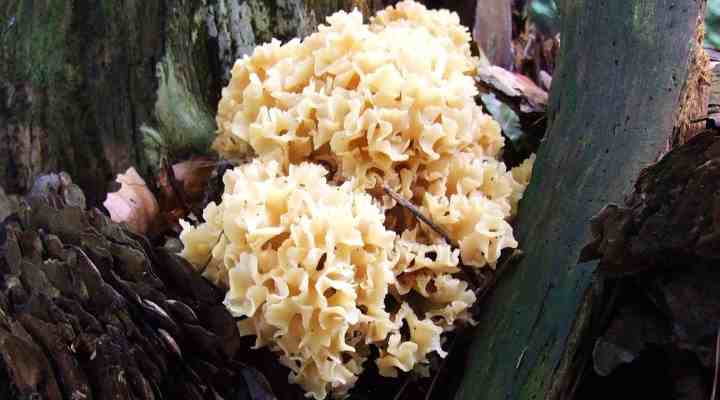
Cauliflower mushrooms are distinctive white fungi found at the base of trees. The striking mushroom looks like a cauliflower head, with caps resembling densely clustered noodles. The entangled rounded globe-like mushrooms have a whitish or pale to bright yellow color and grow up to 24” (60 cm) in diameter.
The cauliflower mushroom is highly prized for its culinary uses. It has a delicate and nutty flavor. However, you should always correctly identify a mushroom species before foraging for edible mushrooms.
Pheasant Back (Cerioporus squamosus)
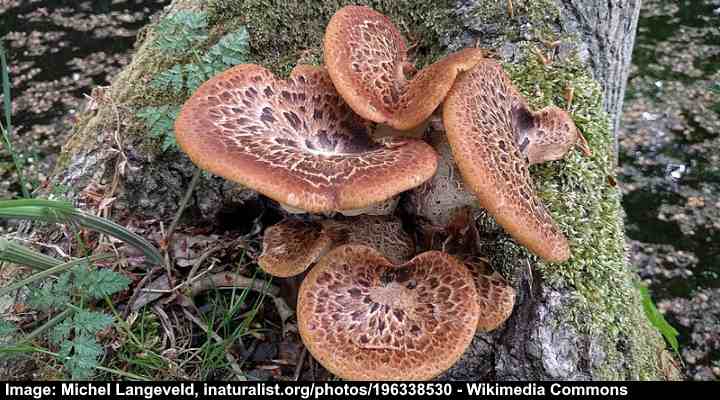
Pheasant back mushroom is a type of bracket fungus commonly found attached to living hardwood trees or dead logs. This parasitic bracket mushroom has a robust stipe 4” (10 cm) thick and a brown fan or kidney-shaped cap 3” to 12” (8 – 30 cm) wide. Its cap has brown to blackish scales in a radial arrangement.
Also called Dryad’s saddle, the edible tree mushroom grows in yards throughout North America. It helps decompose dead wood and decaying matter but can become parasitic on living trees in backyards.
Resinous Polypore (Ischnoderma resinosum)
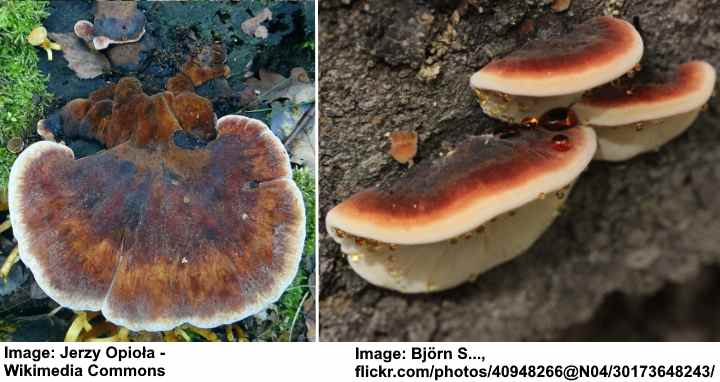
The resinous polypore is a type of bracket polypore mushroom identified by its spongy texture and dark reddish-brown color. The large bracket mushroom grows 3” to 10” (7.5 – 25 cm) across and attaches to the sides of trees. Also called the late fall polypore or benzoin bracket, the fungus fruits on hardwood stumps and logs.
Velvet Foot Mushroom (Flammulina velutipes)
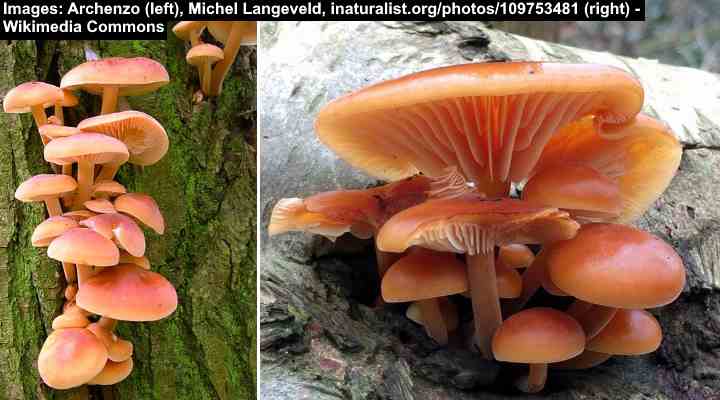
The velvet foot mushroom is an orange to reddish-brown fungus with a characteristic mushroom stem and gilled cap. The saprobic mushroom has stems 0.78” to 4.3” (2 – 11 cm) long and caps 0.39” to 2.75” (1 – 7 cm) wide. The gilled mushroom has whitish-to-pale gills attached to the stem.
The cap mushrooms grow in clusters on the sides of hardwood trees like aspens, poplars, and cottonwoods.
Wood Ear (Auricularia auricula-judae)
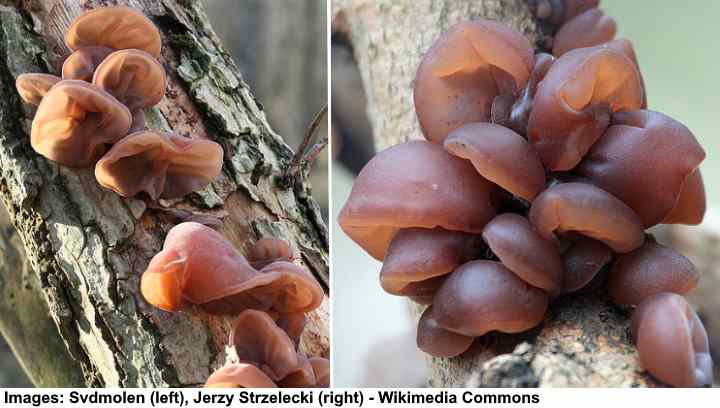
Wood ear is a brown jelly fungus with an ear-like shape that grows on elder trees. The fruiting body has a gelatinous, elastic texture and wrinkled surface and measures 3.5” (9 cm) across. It sprouts on fallen wood and old tree stumps. The unusual brown mushroom becomes purplish as it ages.
Northern Tooth (Climacodon Septentrionale)
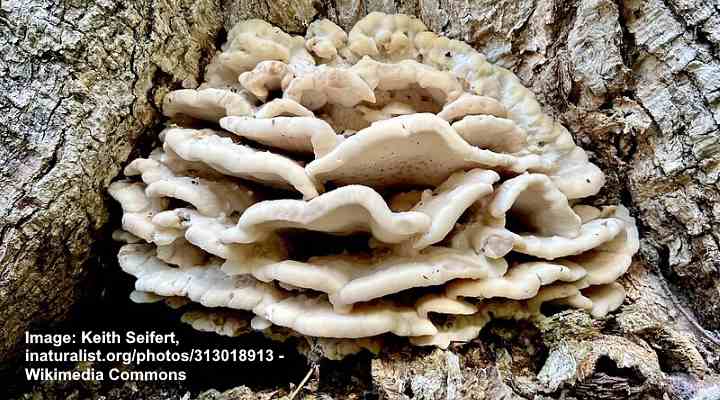
The northern tooth is a white fungus with kidney-shaped whitish caps growing in clumps on living tree trunks. The identifying feature of this common tree mushroom is its tooth-like spines hanging down from the cap’s underside. The individual creamy white caps grow up to 12” (30 cm) across.
Also called the white rot fungus, the species of shelf mushroom damages trees by causing heartwood rot. You will often find this mushroom in your yard if you have maple or beech trees.
Hoof Fungus (Fomes fomentarius)
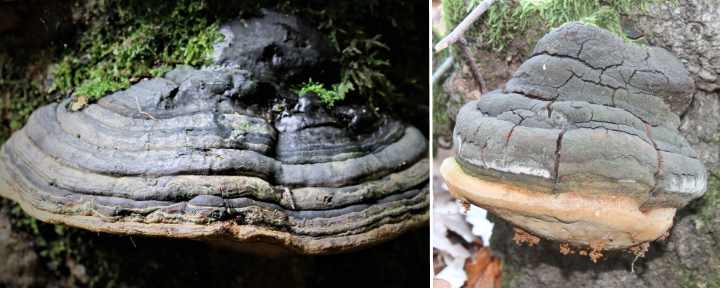
Hoof fungus is an inedible type of shelf fungus commonly found on tree trunks. The dark or light gray mushroom is easy to recognize on trees due to its distinctive hoof-shaped appearance. The large tree fungus grows up to 17.7” (45 cm) across and 10” (25 cm) wide and thick.
Other names for the unusual mushroom are tinder conk and iceman fungus. The parasitic fungus can infect living trees and continues growing on trees after they have died.
Hoof fungus can be found in various habitats, including forests, woodlands, and urban areas. It is commonly found on hardwood trees like birch, beech, and oak.
Artist’s Bracket (Ganoderma applanatum)
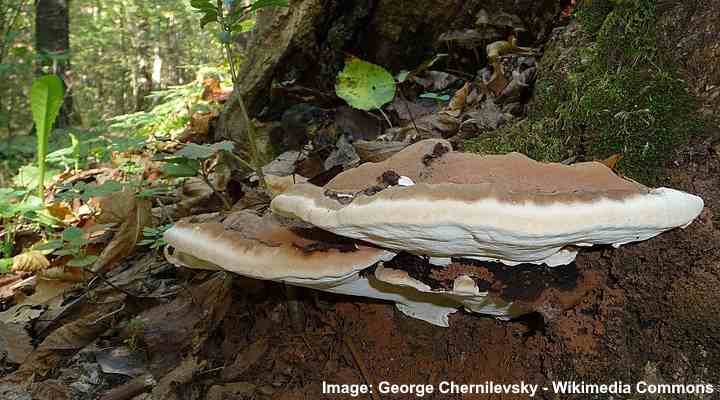
The artist’s bracket is a common type of gray or brown fungus found on hardwood stumps or logs. The distinctive fungus has pale radial markings on its irregularly shaped, bumpy cap, porous white underside, and no stem. The large parasitic fungus grows on hardwood trees, measuring 4” (10 – 30 cm) across.
Artist’s bracket is widely distributed in yards, woodlands, and forests across North America. Once the fungus infects the tree, it produces a straw-colored heartwood and sapwood rot. It’s a common cause of tree death in live oak, maple, horse chestnut, willow, and elm trees.
Witches Butter (Tremella mesenterica)
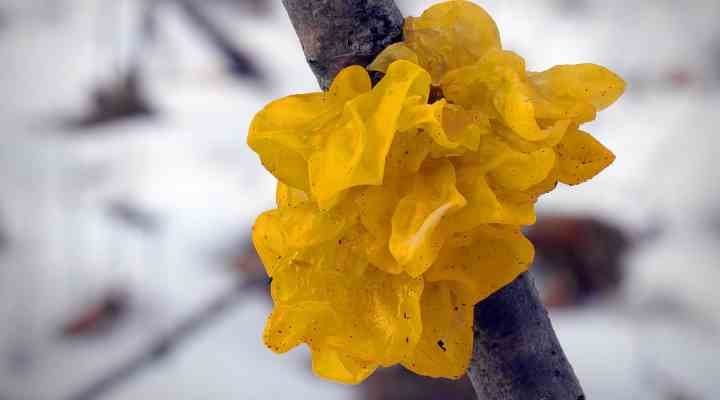
Witches butter is a common yellow mushroom growing on decaying wood, logs, and tree stumps. This unusual mushroom has a gelatinous texture, a bright orange or yellow color, and irregular lobes growing in clumps. The parasitic fungus can appear throughout the year on living front and backyard trees.
The yellow jelly-like mushroom grows 0.78” to 1” (2 – 5 cm) across and up to 1.18” (3 cm) high. It often appears in wet and humid conditions, especially after rainfall. The jelly-like yellow mushroom also goes by the names golden jelly fungus, yellow tremble, and yellow brain fungus.
Shiitake Mushrooms (Lentinula edodes)
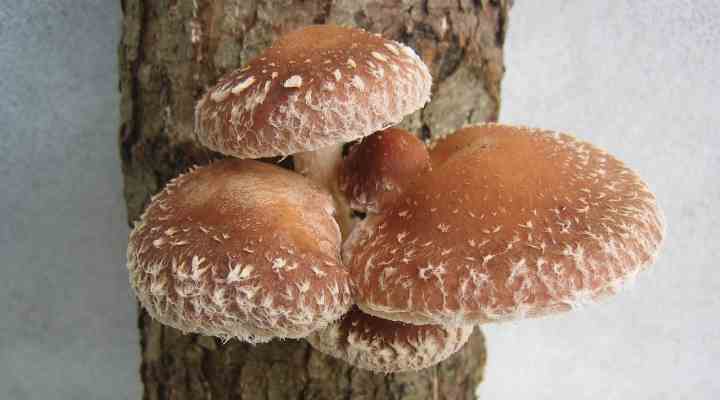
Shiitake mushrooms are popular edible brown mushrooms that grow on decaying wood and thrive in warm, humid climates.
The brown mushrooms have a robust brown cap 2” to 4” (5 – 10 cm) in diameter. The convex caps flatten out as they mature. The cap’s surface is light to dark brown. The underside has white to light brown closely spaced gills. The short, stumpy stems measure 0.39” to 1” (1 to 2.5 cm) thick.
What sets shiitake mushrooms apart is not only their rich flavor but also their distinctive texture. When cooked, shiitake mushrooms develop a firm, meaty texture, making them a satisfying addition to various dishes.
Tremella or Snow Fungus (Tremella fuciformis)
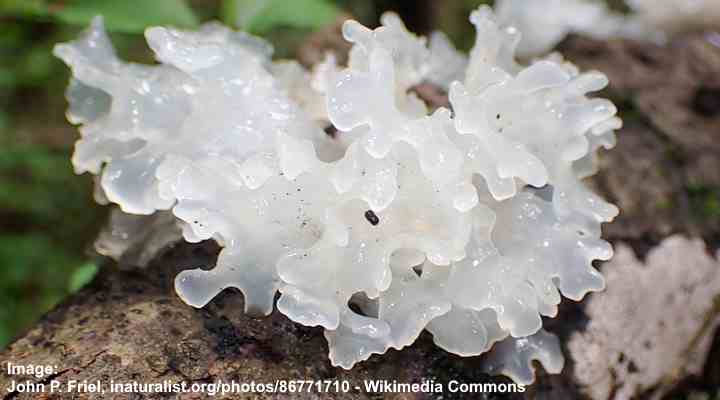
Snow fungus, or silver ear mushroom, is a unique jelly-like mushroom that sprouts on hardwood logs. The unusual white mushroom has a translucent, gelatinous structure with clusters of wavy, seaweed-like lobes. The fruiting body grows 1.6” (4 cm) high and 2.7” (7 cm) wide. The white fungus stands out against gray tree bark.
Chaga Mushrooms (Inonotus obliquus)

Chaga mushrooms are fungi that grow on trees and resemble large, dark, irregularly shaped growths or conks on the trunks of birch trees. These conks can vary in size but are typically quite hard and dense. The outer surface of chaga is dark black and appears charred, while the interior has a rusty brown color. This distinctive appearance is the result of the fungus’s ability to produce melanin, a pigment that protects it from harsh environmental conditions.
Chaga mushroom is a unique fungus that belongs to the fungal family Hymenochaetaceae. It is one of the many mushrooms that thrive on trees, specifically birch trees in cold regions.
Dyer’s Polypore (Phaeolus schweinitzii)
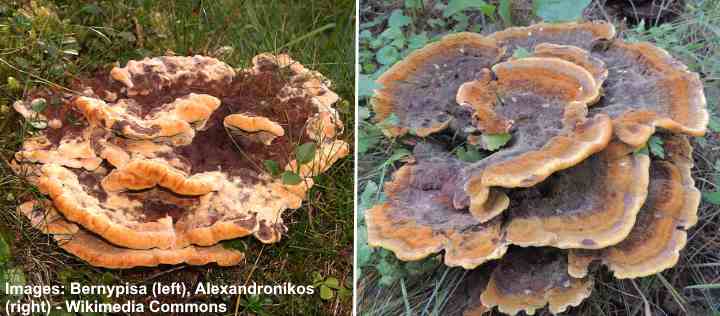
The dyer’s polypore, also known as the velvet-top fungus, is a parasitic mushroom that grows on trees, specifically coniferous trees. This shelf fungus grows close to the ground at the base of the tree and attacks the roots of trees. This mushroom species is primarily found on coniferous trees such as the Douglas fir, spruce, fir, hemlock, pine, and larch.
Phaeolus schweinitzii is recognized by its striking appearance. It typically grows in clusters of large, saucer-shaped caps that can reach sizes of up to 12″ (30 cm) in diameter. These caps are initially bright yellow but become progressively darker with age, eventually taking on a rich, rusty brown or reddish-brown coloration. The mushroom’s upper surface is velvety in texture, which is how it earned the name “velvet-top fungus.”
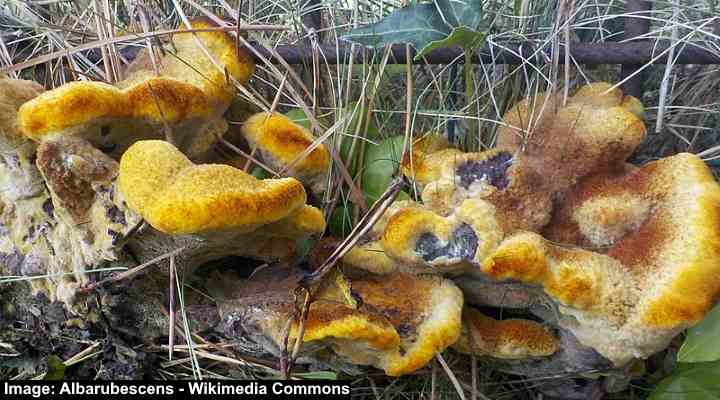
Young dyer’s polypore mushrooms
Frequently Asked Questions About Mushrooms that Grow On Trees
What causes mushrooms to grow on trees?
Mushrooms on trees typically grow due to the presence of decaying organic matter, such as dead wood or tree bark. Trees provide an ideal environment for mushrooms to thrive because they offer moisture, shelter, and a source of nutrients from decaying material.
Are all mushrooms growing on trees edible?
No, not all mushrooms growing on trees are edible, and some can be toxic or even deadly if consumed. It’s crucial to accurately identify the species of mushrooms on a tree before considering them for consumption. Many edible tree-inhabiting mushrooms, such as oyster mushrooms, exist, but expert identification is essential.
How can I identify if the mushrooms on my tree are harmful?
Identifying the specific type of mushroom is crucial for determining whether it is harmful or not. Factors to consider include the mushroom’s color, shape, size, gills, spore print, and any distinctive features. Consult field guides or mycologists for accurate identification and safety.
What are the common types of tree-inhabiting mushrooms?
Common types of tree mushrooms include oyster mushrooms, chicken of the woods, turkey tail, artist’s conk, and various species of shelf fungi. Each has unique characteristics and ecological roles.
Can mushrooms on trees be beneficial for the ecosystem?
Yes, mushrooms on trees can be beneficial. They play a vital role in decomposing dead wood and recycling nutrients back into the ecosystem. Additionally, some tree-inhabiting mushrooms form symbiotic relationships with trees, helping them access essential nutrients and water.
Should I remove mushrooms from my tree, and if so, how?
Whether you should remove mushrooms from a tree depends on their type and purpose. If they are known to be harmful to the tree or if you’re concerned about aesthetics, you can gently remove them by cutting at the base. Be cautious to avoid harming the tree or causing further damage.
Do mushrooms on trees attract pests or wildlife?
Yes, mushrooms on trees can attract insects and wildlife. Some animals, such as squirrels and deer, may feed on certain types of mushrooms. Insects are attracted to the decomposing wood, which can create a micro ecosystem around the mushrooms.
Are there any preventive measures to stop mushrooms from growing on trees?
Preventing mushrooms on trees can be challenging since they are a natural part of the ecosystem. However, maintaining tree health, pruning dead or diseased branches, and improving overall tree vigor can help reduce the conditions that favor mushroom growth.
What is the difference between mycorrhizal and saprophytic mushrooms on trees?
Mycorrhizal mushrooms form mutually beneficial relationships with trees, assisting them with nutrient absorption. Saprophytic mushrooms, on the other hand, decompose dead organic matter, including trees. The key difference lies in their ecological roles.
Can mushrooms on trees be a sign of underlying tree health issues?
Yes, mushrooms on trees can sometimes indicate underlying tree health problems. They often appear on trees that are already weakened or have decaying wood. If you see mushrooms growing on a tree, it’s a good idea to assess the overall health of the tree and address any underlying issues.
Related articles:
- Types of Lawn Mushrooms
- Types of Red and White Mushrooms
- Mushrooms in Potted Plants: Causes and Solutions
